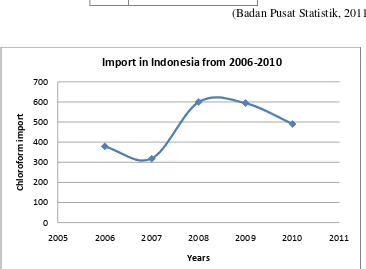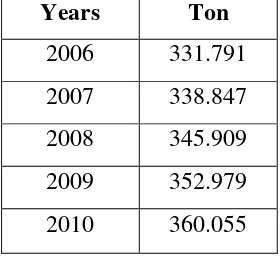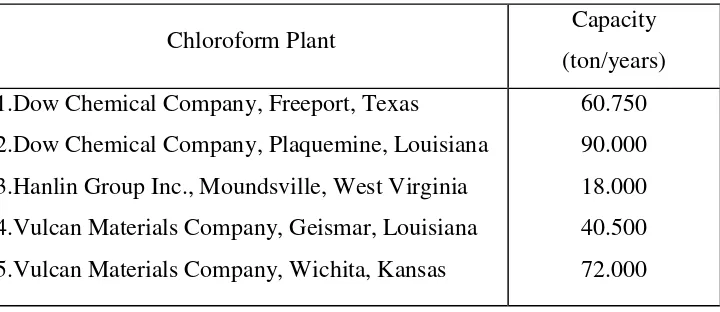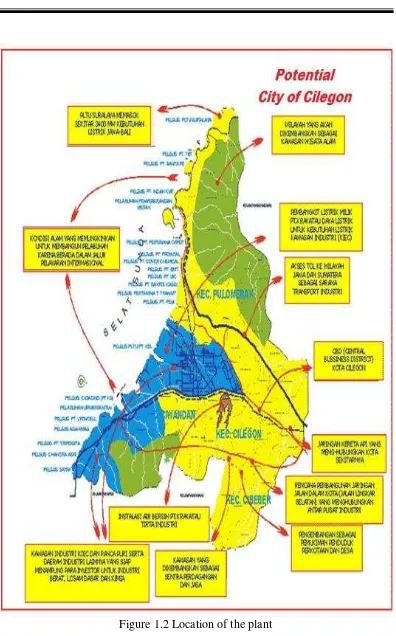Chapter I Introduction
CHAPTER I
INTRODUCTION
1.1 Background
The growth of the world population continues to rise and leads to increases in the need for particular goods. This affects development and establishment of new industries in the world, including in Indonesia. Currently, Indonesia rellies on imports to comply the demand for chloroform. Therefore, by establishing a chloroform plant, it expected that the import can be reduced.
Chloroform is one of the chemicals whose demand is continuously increasing in Indonesia and therefore establishment of chloroform manufacturers will have a prospect so as to meet the need of chloroform both at home and overseas. The establishment of chloroform manufacturers in Indonesia will reduce imports and diversify products with high economic values which add to state revenues and provide employment.
The chemical formula of chloroform is CHCl3. At normal pressure and
temperature, it is a clear liquid with a typical smell. Chloroform is used as an anesthetic and a non-polar solvent in laboratories or by industries. [Amonette et al., 2009]
1.2 The Designed Production Capacity
The maximum amount of production done within a particular unit of time is called production capacity. A manufacturer should have an optimal production capacity as the quantity and the type of the product manufactured should have a maximum profit with minimal costs.
Chapter I Introduction
a. The demand of Chloroform in Indonesia
To meet the need for chloroform, Indonesia is still importing from other countries. The need for chloroform in Indonesia continues to rise as can be seen from 2006 to 2010 in the Tabel 1.1.
Table 1.1 Imports of chloroform in Indonesia from 2006 to 2010 Years Chloroform import (ton)
2006 378.733
Figure 1.1 Demand of chloroform in Indonesia
The increases in the imports of chloroform are consistent with the equation of a straight line:
2005 2006 2007 2008 2009 2010 2011
Chapter I Introduction
Using the equation, it can be estimated that chloroform imports in 2017 will reach 949.8 ton/year The manufacturer capacity is then determined to reach 40,000 ton/year. Thus, besides being able to meet the need of chloroform at home, Indonesia will also be able to make exports abroad.
b. The demand of Chloroform Overseas
The increased need for chloroform abroad makes establishment of chloroform manufacturers has a good future prospect, such an increased need is resulted from the functions of chloroform as an anesthetic and as a nonpolar solvent.
Table 1.2 The demand of Chloroform overseas at 2006 until 2010
Years Ton
2006 331.791 2007 338.847 2008 345.909 2009 352.979 2010 360.055
c. Availability of Raw Materials
Chapter I Introduction
d. Minimum Designed Capacity
Chloroform manufacturers which have been established overseas have a minimum capacity of 18,000 tonnes/year and a maximum capacity of 90,000 tonnes/year.
Table 1.3 Data on the capacity of the manufacturers established abroad
Chloroform Plant Capacity
(ton/years) 1.Dow Chemical Company, Freeport, Texas
2.Dow Chemical Company, Plaquemine, Louisiana 3.Hanlin Group Inc., Moundsville, West Virginia 4.Vulcan Materials Company, Geismar, Louisiana 5.Vulcan Materials Company, Wichita, Kansas
60.750 90.000 18.000 40.500 72.000
Based on several factors above and the projection of the calculation related to increases in chloroform imports per annum, the designed production capacity in 2017 should amount to 40,000 ton/year with the assumptions that it will:
1. Be able to export chloroform as the world demand for chloroform keeps on increasing
2. Boost state revenues through exports to other countries
1.3 Site Selection for the Manufacturer
There are several factors which affect selection of locations where chloroform manufacturers should be established and Cilegon is the right choice for the following reasons:
1. Sources of the Raw Materials
Chapter I Introduction 2. Product Marketing
Manufacturers which use chloroform as their raw materials are polymer manufacturers and these manufacturers are currently growing in Indonesia, especially in Cilegon. This chloroform is also used as raw materials for the manufacture of fungicide and germicide manufactured by fertilizer manufacturers. In addition, Cigading Port is also close to Cilegon industrial area which facilitates the process of good transporting to areas outside Java and abroad.
3. Transportation
The means of transportation around Cilegon industrial area are also quite good since it is situated near land and sea transportation which facilitates the supply of raw materials and product marketing. For example, the supply of raw materials is obtained through land transportation as the area is located nearby Cilegon Highway. While in terms of product marketing to areas outside Java and abroad, it can be done by sea transportation, i.e. ships, as it is close to Cigading Port.
4. Water Facilities
Cilegon is one of the largest industrial area in Indonesia. Therefore, manufacturer establishment in this area always increases sharply every year. This makes the area has adequate facilities, for example the water supply from Cidanau River and PT. Krakatau Tirta Indonesia with a production capacity of 2,000 liters/ second.
5. Labor
The population density of Java Island does keep on increasing every year, so does in Banten. As a result, there are a great number of potential employees to be recruited to work at chloroform manufacturers.
6. Society
Chapter I Introduction
the social and environmental conditions of the area and establishment of new manufacturers here can be accepted easily and adapt quickly.
7. Goverment Rules
An attempt to realize the government policy concerning industrial development and equal employment opportunities can be made by establishing new manufacturers which in turn develop industries in Indonesia and create employments for society.
8. Waste Disposal
During the production process, waste is generated (both solids, liquids and gases). The solid waste produced by chloroform manufacturers is CaCl2. The
wasteis then transported using trucks to be sold to manufacturers which use calcium as their raw materials. For the liquid waste, this type of waste is collected and processed in a sanitation unit using a bleaching powder disinfectant.
9. Energy
To establish a new manufacturer, energy supply and the manufacturer location need considering. The manufacturers to be established in Cilegon supply their electricity need from PLN and the existing generators with a capacity of 900 Kw.
10. Taxes
Every industry in Indonesia is obligated to pay taxes. However, the amount is different in each area. So, the designated location, i.e. in Cilegon can lower the taxes as Cilegon is an industrial area so that the tax payment here is less espensive.
11. Costs of Construction
Chapter I Introduction
Chapter I Introduction 1.4 Literature Reviews 1.4.1 Types of the Processes
In general, there are four ways to make chloroform, namely: 1. Methane chlorination
This process is based on the reaction of methane chlorination with the assistance of alumina as the catalyst. The raw materials used consists of methane at a high purity level and a fixed bed catalytic reactor. The reaction takes place at a temperature of 275 to 450℃. that no longer needs catalyst regeneration,
- The yield produced is quite high, ranging from 90 to 95%. Disadvantages:
- The use of fixed bed reactors requires cantilever construction which is strong to support the catalyst and is made from materials which are resistant to heat liberation, considering the chlorination reaction is a high exothermic reaction. Those make the reactor costs quite expensive,
- This process is sensitive to the presence of impurities.
(Ketta & Cunningham.,1992) 2. Photochemical Chlorination
Chapter I Introduction
a high purity level. The yield of this process reaches 90% and this process utilizes a photochemical reactor.
Advantages:
- To reduce impurities in the resulting chloromethane. Disadvantages:
- Photochemical reactors must be made from a glass surface which is resistant to heat liberation. In addition, energy which produces radiation with a power level by 3000 to 5000 is necessary. As a consequence, the costs of reactor manufacture and maintenance are extremely high,
- since termination of the reaction chain occurs,
- The problem with light transmission to the reaction. Dirt or carbons on the glass surface or which the glass contains will be absorbed and thereby reducing the number of the absorbed components and wasting energy, - The capacity per reactor is low,
- Accumulation often takes place in the reactor area which may lead to explosions.
(Ketta & Cunningham.,1992) 3. Reduction of Carbon Tetrachloride
Reaction:
CCl4 + 2(H) CHCl3 + HCl Yield 70-80%...(1.5)
The reduction of carbon tetrachloride with ethyl alcohol, at the top level, will produce chloroform. The reactions occur in a reactor with a temperature of 200o C for 25. However, these reactions only produce a small amount of chloroform and ethyl chloride. The UV radiation in carbon tetrachloride and alcohol produces chloroform with high conversion. Still, the reaction is very slow.
Advantages:
- The yield is quite high, i.e. 70 to 80%. Disadvantages:
Chapter I Introduction
4. Reactions between acetone and bleaching powder Reaction:
2 CH3COCH3 � + 6 CaOCl2. H2O � 2 CHCl3 � +
Ca CH3COO 2 � + 2 Ca OH 2 � + 3 CaCl2 � + 6 H2O � … … …(1.6)
The reaction between acetone and bleaching powder produces crude chloroform and the product is purified through distillation. Chloroform reacts with the ratio of acetone to bleaching powder by 0.099 lb of acetone: 0.9986 of bleaching powder, the reaction temperature is maintained at about 50℃ by using a cooling device.
Advantages:
- The reaction process is quite simple with a relatively low operating temperature,
- The yield generated is quite high, which ranges from 86 to 91%. Disadvantages:
- The process belongs to the conventional process, - The manufacturing process requires fairly huge costs.
Caused reaction between acetone and bleaching powder is simple and easy, so suitable for use production of chloroform.
(Faith & Keyes,1959) 1.4.2 The Use of the Product
Currently, chloroform is used for the following purposes:
As raw materials for the manufacture of polytetraflouroetilene,
In the pharmaceutical field, as an extracting agent of penicillin,
As raw materials for the manufacture of fungicide and germicide,
Chapter I Introduction
1.4.3 Physical and Chemical Properties 1.4.3.1 Raw Materials
A.The Primary Raw Materials 1. Acetone
a. Physical properties:
Molecular formula : CH3COCH3
Molecular weight : 58.08 g/gmol
Phase : colorless liquid
Density : 0.79 g/cm3
Melting point : -94.9oC
Boiling point : 56.53oC
Critical point : 235.05oC
Viscosity : 0.32 cp (20℃)
Solubility : easily soluble in water
(Kirk & Othmer, 1998) b. Chemical properties:
When acetone is reacted with hydrogen cyanide and sodium cyanide as well as dilute sulfuric acid, the reaction process will result in acetone cyanohydrins.
Reaction:
OH
CH3COCH3 + HCN CH3– C – CH3 ... (1.6)
CN
Acetone, when reacted with iodine and sodium hydroxide, will produce iodoform.
Reaction:
CH3COCH3+4NaOH+3I2 CH3COONa+CHI3+3NaI+3H2O ..(1.7)
Chapter I Introduction
Acetone can be reduced to 2-propanol through the reaction which is aided by lithium aluminum hydride.
Reaction:
Molecular weight : 145.01g/gmol
Phase : white powder
Density : 2.35 g/cm3
Melting point : 100 ℃(decomposed) Solubility in 100 mL of water : 21 g (20℃)
Can react with water and alcohol.
(Kirk & Othmer, 1998) b. Chemical properties:
is resulted from the interaction between bleaching powder gas and calcium hydroxide at a temperature of 40℃.
Reaction:
Ca(OH)2 + Cl2 CaOCl2 + H2O ...(1.9)
CaOCl2 in bleaching powder is reacted with hydrochloric acid so as
to produce calcium chloride and bleaching powder. Reaction:
CaOCl2 + 2 HCl CaCl2 + Cl2+ H2O ...(1.10)
CaOCl2 in bleaching powder is reacted with CO2 and water to
produce calcium carbonate, hypochlorous acid and calcium chloride. Reaction:
2 CaOCl2 + CO2 + H2O CaCO3 + CaCl2 + 2 HOCl ....(1.11)
Chapter I Introduction 1.4.3.2 Product
A. Main Products 1. Chloroform
a.Physical properties:
Molecular formula : CHCl3
Molecular weight : 119.39 g/gmol
Phase : clear liquid
Boiling point : 61.2℃
Melting point : -63.5℃
Density : 1.48 gr/cm3
Critical temperature : 264℃ Specific gravity : 1.489
Viscosity : 0.57 cp (20℃)
Heat capacity : 0.234 kal/g.℃, at 20℃ Critical pressure : 53.8 atm
Solubility in 100 mL water : 0.8 g (20℃)
Chloroform can be reduced using zinc and hydrochloric acid to form methylene chloride. If the reduction is carried out using zinc powder and water, it will generate methane.
Reaction:
CHCl3 + 2 H CH2Cl2 + HCl ...(1.17)
air on light
Chapter I Introduction
CHCl3 + 6 H CH4 + 3 HCl ...(1.18)
Chloroform can react with concentrated nitric acid and form nitrous chloroform or chloropicrin.
Reaction:
CHCl3 + HNO3 CCl3NO2 + H2O ...(1.19)
This chloropicrin is usually used as insecticide.
Chloroform may undergo the process of chlorination due to
Molecular weight : 158.17 g/gmol
Phase : white solid
If a dry distillation process is carried out on calcium acetate, it will generate calcium carbonate and acetone.
Chapter I Introduction
2. Calcium Hydroxide a.Physical properties:
Molecular properties : Ca(OH)2
Molecular weight : 74.1 g/gmol
Phase : white powder
Melting point : 580oC
Density : 2.211 g/cm3
Specific gravity : 2.2
Solubility in water 100 mL : 0.17 g (20oC)
(Perry & Green,1999)
b.Chemical properties:
If carbon dioxide gas is mixed with calcium hydroxide which has been dissolved in water, calcium carbonate is formed. If there is an excess of carbon dioxide gas which is mixed, it will not produce calcium carbonate. Instead, calcium bicarbonate will be produced. Reaction:
Ca(OH)2 + CO2 CaCO3 + H2O ...(1.22)
Ca(OH)2 + CO2 Ca(HCO3)2 + H2O ...(1.23)
Calcium hydroxide can react with the acid chloride to produce calcium chloride.
Reaction:
Ca(OH)2 + 2 HCl CaCl2 + 2 H2O ...(1.24)
Calcium hydroxide which reacts with sulfuric acid will form calcium sulfate.
Reaction:
Ca(OH)2 + H2SO4 CaSO4 + 2 H2O ...(1.25)
(dissolve in water)
Chapter I Introduction
Calcium hydroxide which reacts with nitric acid will form calcium nitrate.
Reaction:
Ca(OH)2 + 2 HNO3 Ca(NO3)2 + 2 H2O ...(1.26)
(Kirk & Othmer, 1998) 3. Calcium Chloride
a.Physical properties:
Molecular formula : CaCl2
Molecular weight : 110.98 g/gmol
Phase : white powder
Density : 2.15 g/cm3
Melting point : 772℃
Boiling point : 193℃
Solubility in water 100 mL : 74 g (20℃)
(Kirk & Othmer, 1998)
b.Chemical properties:
Calcium chloride which reacts with sodium hydroxide will form calcium hydroxide and sodium chloride.
Reaction:
CaCl2 + 2 NaOH Ca(OH)2 + 2 NaCl ...(1.27)
Calcium chloride which reacts with sodium carbonate will form calcium carbonate and sodium chloride.
Reaction:
CaCl2 + Na2CO3 CaCO3 + 2 NaCl ...(1.28)
Chapter I Introduction 4. Water
a.Physical properties:
Molecular formula : H2O
Molecular weight : 18.02 g/gmol
Phase : colorless liquid
Density : 0.9982 g/cm3
Freezing point : 0℃
Boiling point : 100℃
Critical pressure : 216.531 atm Critical temperature : 373.98℃
(Perry & Green,1999) b.Chemical properties:
Water is a weak electrolyte which can conduct electricity because it is ionized into H+ and OH- ions.
Reaction:
H2O H+ + OH- ...(1.29)
Water can break salts into acid and alkaline (salt hydrolysis), Water is neutral (pH=7),
Water is a good solvent,
Water is a polar covalent compound,
Water which reacts with metal oxide will form alkaline hydroxide, Water which reacts with non-metal oxide will form acid.
(Pudjaatmaka & Setiono,1984) 1.4.4 General Process Overview
The process of chloroform production is actually the process of reacting acetone with bleaching powder, the reaction is given as follows: 2 CH3COCH3(l) + 6 CaOCl2.H2O(s) 2 CHCl3(l) + Ca(CH3COO)2(s) + 2
Ca(OH)2 (s) +3 CaCl2(s)+ 6 H2O(l)
Chapter I Introduction
The type of reactor used was the batch reactor which is equipped with a stirrer and a heating coil. The reactant comparison is 0.045 kg of acetone: 0.453 kg of bleaching powder. The reaction took place at a temperature of 50º C and 1 atm pressure in an exothermic reaction. Besides chloroform as the main products, the batch reactor also produces calcium acetate, calcium hydroxide and calcium chloride. In the light phase of the decanter, chloroform was produced which was then brought into the distillation tower for purification so that its purity level reaches 99%.



